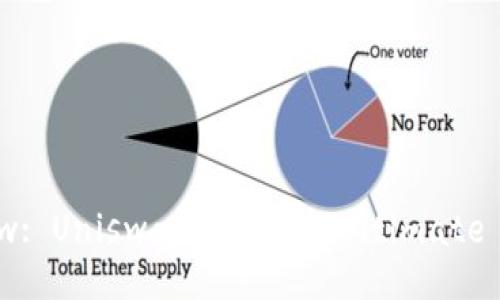Ethereum Wallet Review: Uniswap – The Ultimate Decentralize
Setting up an Ethereum wallet is an easy process that can be completed in just a few steps. Follow these steps:
Step 1:
Choose a wallet provider – there are several wallet providers to choose from such as Exodus, MyEtherWallet, MetaMask, Ledger Nano S etc.
Step 2:

Create an account – you will need to create an account with your chosen wallet provider and follow the prompts to secure your account with a password.
Step 3:
Backup your wallet – you will be given a 12 to 24-word seed phrase that you need to write down and store somewhere safely. This phrase can help you regain access to your wallet in case you forget your password or lose access to your account.
Step 4:

You’re all set – now you can start buying and storing Ethereum in your wallet.
What is Uniswap?Uniswap is a decentralized exchange built on the Ethereum blockchain that allows users to trade ERC-20 tokens without the need for an intermediary. It operates on an Automated Market Maker (AMM) model that enables users to contribute their tokens to liquidity pools rather than needing an order book.
Features of Uniswap:1. No Traditional Order Book:
Uniswap operates on an Automated Market Maker model, which means that it does not require a traditional order book to match buyers and sellers. Instead, liquidity providers (LP) deposit an equal amount of two different ERC-20 tokens into the liquidity pool and the price is automatically determined based on the supply and demand for each token.
2. Minimal Fees:
The fee for each trade on Uniswap is 0.3%, which is much lower than traditional exchanges. This fee is paid to the LPs who contribute to the liquidity pool, incentivizing them to keep their tokens in the pool and attract more traders.
3. No KYC/AML Requirements:
Uniswap operates in a decentralized manner and does not require any KYC/AML verification to trade. This means that users can trade anonymously without the need to disclose their identity.
4. Self Custody of Funds:
Uniswap operates on the Ethereum blockchain, which means that users have complete control and custody of their funds. There is no need for a trusted third party to hold users’ funds.
Uniswap Liquidity Pools:Uniswap liquidity pools are pools of tokens that users contribute to in order to facilitate trades. Each pool consists of two different ERC-20 tokens and the price of each token is determined by the ratio between the tokens in the pool.
How to Trade on Uniswap:Step 1:
Connect your Ethereum wallet to Uniswap – you can do this by opening the Uniswap website and connecting your wallet provider that holds the tokens you want to trade.
Step 2:
Select the tokens you want to trade – you can choose any ERC-20 token you want to trade from the list of available tokens on Uniswap.
Step 3:
Enter the amount you want to trade – once you’ve chosen your tokens, enter the amount you want to trade and click ‘Swap’.
Step 4:
Confirm the transaction – confirm the details of your trade and approve the transaction. Once your transaction is confirmed on the Ethereum blockchain, your trade is complete.
How Safe is Uniswap?Uniswap is a decentralized exchange, meaning that there is no central authority controlling it. Therefore, it is less vulnerable to hacking and other security breaches. However, there is always a risk associated with any financial transaction, especially with the price volatility of cryptocurrencies.
Pros and Cons of Uniswap:Pros:
Low transaction fees, no KYC/AML requirements, self-custody of funds, transparent, and open-source.
Cons:
High risk of impermanent loss for liquidity providers, price slippage, limited order book, limited token offerings, and high gas fees during peak trading periods.
Comparison with Other Decentralized Exchanges:Uniswap has established itself as one of the leading decentralized exchanges and has gained a lot of popularity among cryptocurrency traders. However, there are other decentralized exchanges such as Kyber Network, Bancor, and 0x which offer similar features and services.
Conclusion:Uniswap is a decentralized exchange that offers a unique trading experience for ERC-20 tokens. It has proven to be a popular choice among cryptocurrency traders due to its low fees, easy-to-use interface, and no KYC/AML requirements. However, as with any financial transaction, there is always a certain level of risk involved. It is recommended that users do their own research and practice caution when trading on Uniswap or any other decentralized exchange.
Related Questions:1. What are ERC-20 tokens?
ERC-20 tokens are a type of cryptocurrency that are built on the Ethereum blockchain and follow a set of rules and standards defined by the ERC-20 protocol.
2. What is an Automated Market Maker (AMM)?
An Automated Market Maker is a type of decentralized exchange that uses algorithms to automatically set prices based on supply and demand for different assets.
3. What is impermanent loss?
Impermanent loss occurs when the price of tokens in a liquidity pool changes, causing liquidity providers to lose some of their investment.
4. How can I reduce my risk when trading on Uniswap?
Users should do their own research, only invest what they can afford to lose, and use caution when trading on any exchange, including Uniswap. It is also recommended to use limit orders instead of market orders to avoid price slippage.
5. How can I contribute to a liquidity pool on Uniswap?
Users can contribute to a liquidity pool by depositing an equal amount of two different ERC-20 tokens into the pool and receiving liquidity provider (LP) tokens in return.
6. What are gas fees?
Gas fees are the fees users need to pay to use the Ethereum blockchain. These fees are paid in ETH and are calculated based on the complexity and amount of data used by the transaction.



